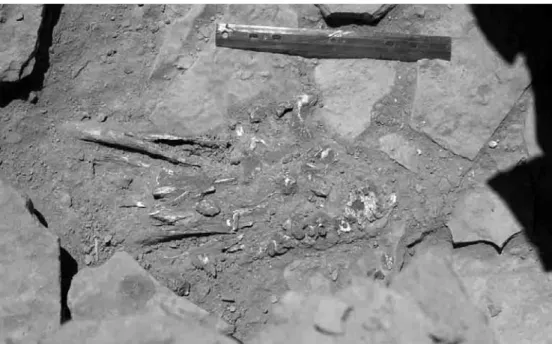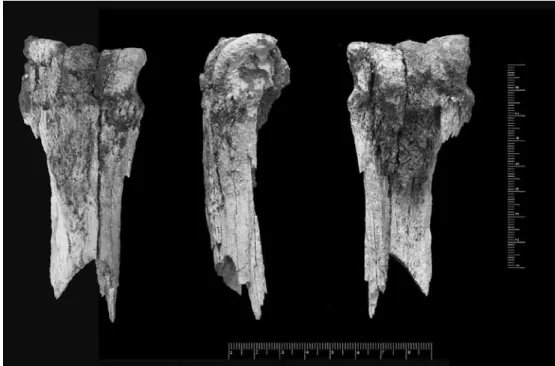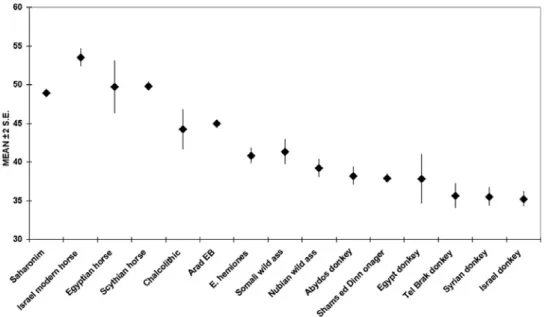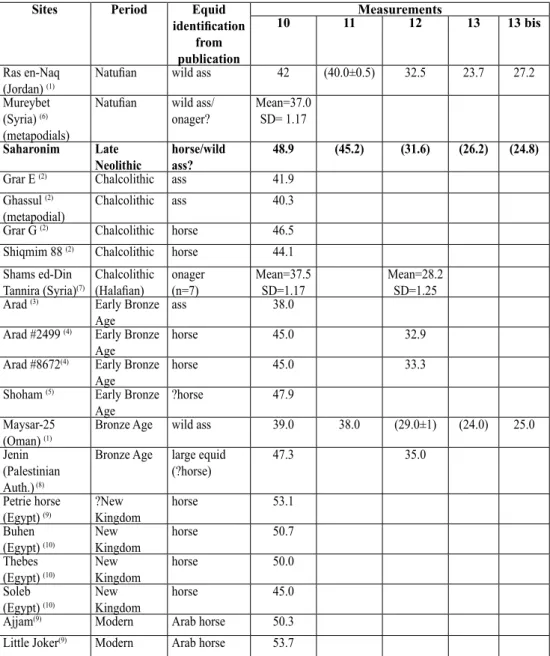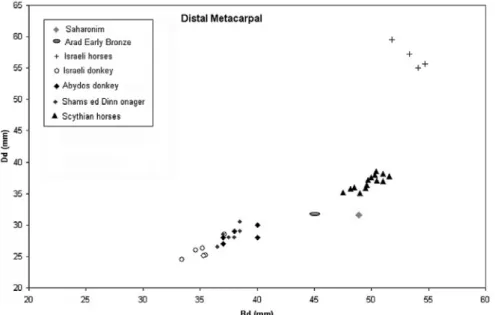HAL Id: hal-02013827
https://hal.parisnanterre.fr//hal-02013827
Submitted on 11 Feb 2019HAL is a multi-disciplinary open access
archive for the deposit and dissemination of sci-entific research documents, whether they are pub-lished or not. The documents may come from teaching and research institutions in France or abroad, or from public or private research centers.
L’archive ouverte pluridisciplinaire HAL, est destinée au dépôt et à la diffusion de documents scientifiques de niveau recherche, publiés ou non, émanant des établissements d’enseignement et de recherche français ou étrangers, des laboratoires publics ou privés.
A Late Neolithic Equid Offering from the Mortuary-Cult
Site of Ramat Saharonim in the Central Negev
Liora Kolska Horwitz, Steven Rosen, Fanny Bocquentin
To cite this version:
Liora Kolska Horwitz, Steven Rosen, Fanny Bocquentin. A Late Neolithic Equid Offering from the Mortuary-Cult Site of Ramat Saharonim in the Central Negev. Journal of the Israel prehistoric society, Israel Prehistoric Society, 2011, 41, pp.71-81. �hal-02013827�
A Late Neolithic Equid Offering from the
Mortuary-Cult Site of Ramat Saharonim
in the Central Negev
LIORA KOLSKA HORWITZ1
STEVEN A. ROSEN2
FANNY BOCQUENTIN3
1 National Natural History Collections, Faculty of Life Science, The Hebrew University, Berman Bld., Jerusalem 91904, Israel
2 Archaeological Division, Ben Gurion University of the Negev, PO Box 3653, Beersheva, Israel 3 UMR 7041 du CNRS, Ethnologie Préhistorique, 21 Allée de l’Université,
F-92023 Nanterre Cedex, France
ABSTRACT
The lower forelimb (metacarpal) of an equid, identified as that of a very large wild ass (E. africanus africanus) or a small sized wild horse (E. caballus), was recovered during excavations of a tumulus at Ramat Saharonim in the Central Negev. Given its close association with a Late Neolithic (Timnian) human interment, we have interpreted this bone as representing an early example of a grave offering from the Levantine deserts.
INTRODUCTION
Ramat Saharonim is a Late Neolithic ritual complex in Makhtesh Ramon in the central Negev extending over an area of approximately 8 hectares. It comprises a set of four, large open-air shrines aligned with the setting sun of the summer solstice, and 30 large burial tumuli (Fig. 1) (Rosen and Rosen 2003; Rosen et al. 2007). Excavations at Shrine 4 and Tumuli 28, 29, and 30 at the southwest edge of the complex have established the contemporaneity of these structures dated to ca. 5000 cal. BC (Porat et al. 2006). The complex reflects the existence of
an elaborate mortuary cult associated with the early phase of the Timnian Culture, the early desert pastoral society in the region (Rosen 2010: 204-206). This report describes an equid metacarpal, discovered in association with human remains in Tumulus 29. It provides new information on mortuary practices in the southern Levantine desert region at this time.
TUMULUS 29
Tumulus 29 (Fig. 1) is large burial cairn located at the far west end of the site. It is preserved to a height of approximately 1.5 m and approximately 4 m across at the base. It consists of a central cist constructed on bedrock, with the tumulus itself constructed of slabs and large blocks of limestone piled around the cist. The blocks were quarried in the immediate vicinity of the site.
Excavation yielded two distinct archaeological levels within the cist, both with human skeletal remains. The upper level (1.68-1.40 m above datum) contained the well-preserved human skeleton of an old adult female (Fig. 2a), apparently interred in a leather sack, dated by radiocarbon and OSL to the late 1st millennium BC (Porat et al. 2006), and perhaps attributable to the Nabateans given the proximity of the Nabatean Spice Road. The lower level (1.02-0.89 m above datum, and slightly above bedrock) contained fragments of long bones of an unsexed adult (Fig. 2b). Sediment from 2cm underneath the lower skeleton was dated by OSL to 7500±700 BP (i.e. the Late Neolithic) and represents the sediment at the
Fig. 2a: The upper 1st millennium BC (Nabatean) adult female burial
Fig. 2b: The lower Late Neolithic unsexed adult burial. Note marked difference in preservation between the two burials
time of burial (Rosen et al. 2007: Table 2), while the sediment in which the lower skeleton was found (i.e. post-dating its burial), gave an OSL date of 6000±600. The lower skeleton was separated from the upper level by a combination of rock fall and quantities of windblown sediment. A partial and highly fragmented distal metacarpal III of an equid was found in the sediment immediately above the human remains (1.10-1.05 m above datum), cemented by concretions to the lower edge of one of the stones situated immediately above the skeleton. Both the stratigraphic relationship and the poor state of preservation of the metacarpal, identical to that of the underlying human remains, indicate that it is associated with the lower, Late Neolithic burial.
THE EQUID
The Saharonim bone represents a fused, distal metacarpus with a small portion of the shaft preserved (Fig. 3). Given that the proximal end of the shaft has an old green-fracture break, the bone may have been complete when introduced into the tumulus and disintegrated there. The distal epiphysis is fused, such that the animal was older than 1-1.5 years (Silver 1969). The surviving fragment is poorly preserved; the bone is fissured, very friable and its surface
Fig. 3: Distal equid metacarpal from Saharonim T29. Photographs: (left) plantar aspect; (centre) dorsal (cranial) aspect; (right) volar (palmar) aspect
Fig. 4: Bar plot comparing distal breadth (measurement 10 in Table 1) in the Saharonim equid and other modern and archaeological specimens. Mean distal breadth measurements is shown to 2± with ±2 SD to give a 95% confidence limit for samples.
Samples: Israel horse – modern horses (Horwitz, unpublished data from Arad hyaena den); Egyptian horse – New Kingdom horses (Clutton Brock 1974); Scythian horse (Benecke 2007); Chalcolithic – Negev sites (Grigson 1993); Arad – Early Bronze Age, Negev desert (Davis 1976); Abydos donkey – Early Dynastic Egypt (Rossel et al. 2008); Shams ed-Din – Halafian period, probably onagers (Uerpmann 1986); Tel Brak donkey – Akkadian period (Clutton-Brock and Davies 1993); Modern E. hemionus (Gilbert 1991: Table 9); Modern Somali wild ass, Nubian wild ass, Egypt donkey, Syrian donkey (Rossel et al. 2008); Modern Israeli donkeys (Davis 1976).
exfoliated (Fig. 3). Given the fragmentary nature of this specimen it was not possible to determine the side of the bone element nor could it be examined for cut marks or animal damage.
Identification of the equid species was based on standard biometric measurements. As shown in Table 1, and Figures 4 and 5, breadth of the Saharonim distal metacarpal is greater than that of modern and archaeological wild and domestic donkeys as well as onagers. It is also broader than the E. caballus specimens identified from Arad (Early Bronze Age) and other Chalcolithic sites in the Negev. Based on its biometry it falls closest to small Scythian horses and Egyptian New Kingdom horses.
In order to provide additional information, body weight of the Saharonim equid was estimated using Eisenmann’s (2009) equation for the metacarpal where:
Sites Period Equid identification from publication Measurements 10 11 12 13 13 bis Ras en-Naq
(Jordan) (1) Natufian wild ass 42 (40.0±0.5) 32.5 23.7 27.2 Mureybet
(Syria) (6) (metapodials)
Natufian wild ass/
onager? Mean=37.0SD= 1.17
Saharonim Late
Neolithic horse/wild ass? 48.9 (45.2) (31.6) (26.2) (24.8)
Grar E (2) Chalcolithic ass 41.9 Ghassul (2)
(metapodial) Chalcolithic ass 40.3 Grar G (2) Chalcolithic horse 46.5 Shiqmim 88 (2) Chalcolithic horse 44.1 Shams ed-Din
Tannira (Syria)(7) Chalcolithic (Halafian) onager(n=7) Mean=37.5SD=1.17 Mean=28.2SD=1.25 Arad (3) Early Bronze
Age ass 38.0 Arad #2499 (4) Early Bronze
Age horse 45.0 32.9 Arad #8672(4) Early Bronze
Age horse 45.0 33.3 Shoham (5) Early Bronze
Age ?horse 47.9 Maysar-25
(Oman) (1) Bronze Age wild ass 39.0 38.0 (29.0±1) (24.0) 25.0 Jenin
(Palestinian Auth.) (8)
Bronze Age large equid
(?horse) 47.3 35.0 Petrie horse
(Egypt) (9) ?New Kingdom horse 53.1 Buhen
(Egypt) (10) NewKingdom horse 50.7 Thebes
(Egypt) (10) NewKingdom horse 50.0 Soleb
(Egypt) (10) NewKingdom horse 45.0 Ajjam(9) Modern Arab horse 50.3 Little Joker(9) Modern Arab horse 53.7
(1) Uerpmann 1991 (2) Grigson 1993 (3) Lernau 1978 (4) Davis 1976 (5) Horwitz 2007 (6) Ducos 1986 (7) Uerpmann 1986 (8) Al-Zawahra & Ezzughayyar 1998 (9) Clutton-Brock & Burleigh 1979 (10) Clutton-Brock 1974
* All measurements in mm; codes follow Eisenmann (2009): 10=Distal supra-articular breadth; 11=Distal articular breadth; 12=Depth of the sagittal crest; 13=Least depth of the medial condyle; 13bis=Least depth of the lateral condyle.
Table 1: Measurements of the distal equid metacarpus III from Saharonim compared to other archaeozoological specimens from the Near East
estimated weight = -4.525 + 1.434 (Ln (MC10* MC13)).1
Using this equation, the rough weight estimate for the Saharonim equid was 184 kgs. Using the same method, weight estimates were calculated for the early Dynastic donkeys from Abydos (Egypt) and a sample of modern free-ranging African wild asses taken from the literature. Both were much lighter than the Saharonim equid; the Abydos donkeys had a mean weight of 124 kgs (range 110-137 kgs) and the modern African wild asses had a mean weight of 133 kgs (range 107-156 kgs). In comparison, average adult body mass of the wild Przewalski horse (14-18 hands2 in withers height) is 200-300 kgs (Bennett and Hoffmann
1999), while modern horses (ca. 14 hands high) have weights of 400 kgs and higher; modern ponies (9-13 hands in height) have weights of 200-300 kgs; and modern donkeys (9-13 hands in height) have weights of 150-350 kgs (http//www.saracean-horse-feeds.uk). Unfortunately, no weight estimates could be calculated for the New Kingdom or Scythian horses since neither publication provided measurements of the minimal depth of the metacarpal medial condyle (measurement 13).
Fig. 5: Scattergram showing distal metacarpal breadth (measurement 10) against depth (measurement 12). References for samples are the same as for Fig. 4
1 Ln of the weight = -4.525 + 1.434 [Ln of the product of metacarpal supra-articular width (MC10) by the minimal depth of the metacarpal medial condyle (MC13)]. See Table 1 for location of measurements MC10 and MC13.
In conclusion, the Saharonim equid appears to be an adult animal. In terms of size and estimates of body weight, it falls closer in these parameters to ponies and small horses than to wild or domestic asses or onagers.
DISCUSSION
With the exception of suspected E. caballus remains from Wadi Tbeik in Sinai (Bar-Yosef and Tchernov 1982), the Pre-Pottery Neolithic equids from the deserts of the Southern Levant have been identified as either wild ass (E. africanus africanus) or wild onager (E.
hemiones) (e.g., Becker 1991, von den Driesch et al. 2004). In subsequent Pottery
Neolithic-Chalcolithic contexts in this southern region, equid remains are generally found in small numbers. With the exception of several Northern Negev Chalcolithic specimens identified as domestic horses (Davis 1976, Grigson 1993, 2005, 2006), most specimens have been attributed to domestic donkey (e.g., Ducos 1968, Horwitz 1987, Grigson 2006, Ovadia 1992, Milevski 2010: Table 10.2). The Saharonim equid is however larger than the Northern Negev Chalcolithic horses and falls outside the 95% confidence range of these specimens (Figs. 4 and 5). This raises several possibilities:
(i) a large, as yet unidentified species of equid inhabited the Negev in the early Holocene. (ii) in the Late Neolithic-Chalcolithic, wild E. africanus africanus in the Negev was much
larger than modern specimens of this species that are used as standards today (see discussion in Horwitz 2007).
(iii) as implied by the Wadi Tbeik remains (Bar-Yosef and Tchernov 1982), the wild horse (E. caballus) continued to inhabit the Southern Levant and did not became extinct at the end of the Pleistocene, as suggested by (Davis 1980).
(iv) as contended by Davis (1976) and Grigson (1993, 2005, 2006), by the Chalcolithic-Early Bronze Age domestic horses inhabited the Negev, but if the Saharonim equid is a domestic horse, then they exhibited a wider size range than previously documented. Given that the Saharonim specimen falls in the lower size range of two small-sized later horse populations, the last two possibilities cannot be unequivocally excluded on metrical grounds. However, if option (iv) is accepted then the Saharonim specimen would represent the earliest domestic horse, not only in the Levant but earlier even than those claimed from Central Asia i.e. 4th millennium BC (Anthony 2007). Given our present knowledge of horse domestication, this seems unlikely. In our opinion, options (ii) and (iii) are the most parsimonious explanations, with the bone representing either an extremely large wild E.
africanus africanus or a wild E. caballus.
Regardless of the taxonomic status of the Saharonim metacarpal, its intentional interment in a human burial invites speculation concerning the role played by animals in Late Neolithic
desert mortuary rituals. The poor preservation of the Late Neolithic human bones in T29 prohibits reconstruction of the actual process of interment, but in the Late Neolithic Tumuli, T28 and T30, both primary and secondary interments are found (Rosen et al. 2007). The interments were placed in the cavity at the base of the tumuli and in the case of T29, an equid bone was placed above the deceased. The bone could not have been introduced into the cavity following the interment without first removing the overlying rock slabs. Furthermore, the bone is unlikely to have fallen down from the upper Nabatean burial given that: (a) rock fall and a quantity of sediment separate the two interments, (b) the state of preservation of the metacarpal was identical to that of the underlying human remains, and differed markedly from the overlying Nabatean skeleton, and (c) no faunal remains were found with the Nabatean skeleton. The slight vertical difference between the equid bone and lower human remains can be explained as the result of movement of material within the grave as the bones settled. It does not reflect a chronological difference. We therefore conclude that the equid bone was intentionally introduced and interred together with the body.
The Saharonim bone may represent a precursor of the isolated equid limbs recovered from Middle Bronze Age II burials and ceremonial contexts at Tell el-Ajjul (Bodenheimer 1960:184). Like these, it probably represents a pars pro toto, with the remainder of the animal maybe consumed elsewhere, either on or off-site, in a ritual feast accompanying the mortuary ritual (e.g., a variant of the ‘Bos pit’ from Kfar Hahoresh ‒ Goring Morris and Horwitz 2007). Such a scenario would accord well with the social changes in desert society reflected in the construction of large shrines and tumuli indicating communal activities.
Animal remains, interpreted as burial offerings, are known from other Late Neolithic-Chalcolithic desert sites such as the Nawamis in Sinai (Bar-Yosef et al. 1977) and the Late Neolithic cemetery in Eilat (Horwitz and Avner in press). Consequently, the Saharonim equid joins a small but growing corpus of information on this regional phenomenon.
ACKNOWLEDGEMENTS
Special thanks to Gali Beiner for her meticulous conservation work without which it would not have been possible to analyse the Saharonim equid and to Charlene Dalbera for information on the human burials. Excavations at Ramat Saharonim were conducted with the support of the National Geographic Society.
REFERENCES
Al-Zawahra, M. and Ezzughayyar, A. 1998. Equid Remains from the Bronze Age Periods at Site 4 of Tell Jenin (Palestine). In Buitenhuis, H., Bartosiewicz, L. and Choyke, A. M. (eds.), Archaeozoology
Anthony, D. W. 2007. The Horse, the Wheel, and Language: How Bronze-Age Riders from the Eurasian
Steppes Shaped the Modern World. Princeton University Press.
Bar-Yosef, O. and Tchernov, E. 1982. Animal exploitation in the Pre-Pottery Neolithic B Period at Wadi Tbeik, Southern Sinai. Paléorient 8/2: 17-37.
Bar Yosef, 0., Belfer A., Goren A., and Smith, P. 1977. The nawamis near “Ein Huderah.” Israel
Exploration Journal 27(2-3): 65-88.
Becker, C. 1991. The Analysis of Mammalian bones from Basta, a Pre-Pottery Neolithic site in Jordan: problems and potential. Paléorient 17/1: 59-75.
Benecke, N. 2007. The horse skeletons from the Scythian royal grave mound at Arzan 2 (Tuva, W. Siberia). In: Grupe, G. and Peters, J. (eds.), Skeletal Series and their Socio-Economic Context.
Documenta Archaeobiologiae. Vol. 5. pp. 115-131. Verlag Marie Liedorf GmbH: Rahden/Westf.
Bennett, D. and Hoffmann, R. S. (1999). Equus caballus. Mammalian Species 628: 1-14. Bodenheimer, F. S. 1960. Animal and Man in Bible Lands. Leiden: Brill.
Clutton-Brock, J. 1974. The Buhen horse. Journal of Archaeological Science 1: 89-100.
Clutton-Brock, J. and Burleigh, R. 1979. Notes on the osteology of the Arab Horse with reference to a skeleton collected in Egypt by Sir Flinders Petrie. Bulletin of the British Museum of Natural History
(Zoology) 35:127-200.
Clutton-Brock, J. and Davies, S. 1993. More donkeys from Tel Brak. Iraq 55: 209-221.
Davis, S. 1976. Mammal bones from the Early Bronze Age city of Arad, northern Negev, Israel: some implications concerning human exploitation. Journal of Archaeological Science 3: 153-164. Davis, S. J. 1980. Late Pleistocene and Holocene equid remains from Israel. Zoological Journal of the
Linnean Society 70/3:289-312.
Driesch, von den A., Cartajena, I. and Manhart, H. 2004. The Late PPNB site of Ba’ja, Jordan: the faunal remains (1997 season). In: Bienert, H.D., Gebel, H.G.K and Neef, R. (eds.), Central Settlements in Neolithic Jordan. Studies in the Early Near Eastern production, Subsistence and Environment 5. pp. 271-288. Berlin, ex oriente.
Ducos, P. 1968. L’Origine des Animaux Domestiques en. Palestine. Publications de l’Institut de Préhistoire de l’Université de Bordeux, Memoire 6. Delmas.
Ducos, P. 1986. The Equid of Tell Muraibit, Syria. In: Meadow, RH, Uerpmann, H-P. (eds.), Equids in the
Ancient World I. Beihefte zum Tubinger Atlas des Vorderen Orients. Reihe A (Naturwissenschaften)
19/1. Wiesbaden: Reichert. Reihe A (Naturwissenschaften) 19/1. pp. 237-245. Wiesbaden: Reichert. Eisenmann, V. 2009. Système de mesures pour les os et les dents d’Equus. Metapodials http://www.
vera-eisenmann.com/outils-systeme-de-mesures-pour-les-os-et-les-dents-dequus-rubrique670.html. Gilbert, A. 1991. Equid remains from Godin Tepe, Western Iran: an interim summary and interpretation, with notes on the introduction of the horse into southwestern Asia. In: Meadow, R. H. and Uerpmann, H-P. (eds.), Equids in the Ancient World I. Beihefte zum Tubinger Atlas des Vorderen Orients. Reihe A (Naturwissenschaften) 19/2. pp. 75-122. Wiesbaden: Reichert.
Goring-Morris, A. N. and Horwitz, L. K. 2007. Funerals and feasts in the Near Eastern Pre-Pottery Neolithic B. Antiquity 81: 902-919.
Grigson, C. 1993. The earliest domestic horses in the Levant? New finds from the fourth millennium of the Negev. Journal of Archaeological Science 20: 645-655.
Grigson, C. 2005. Cattle-keepers of the Northern Negev: Animal remains from the Chalcolithic site of Grar. In: Gilead, I. (ed.), Grar: A Chalcolithic Site in the Northern Negev. pp. 377-481. Beersheva: Ben-Gurion University Press.
Grigson, C. 2006. Farming? Feasting? Herding? Large Mammals from the Chalcolithic of Gilat. In: Levy, T. E. (ed.), Archaeology, Anthropology and Cult. The Sanctuary at Gilat, Israel. pp. 215-319. London: Equinox.
Horwitz, L. K. 1987. Animal remains from the Pottery Neolithic levels at Tel Dan. Journal of the Israel
Prehistoric Society 26: 114-119.
Horwitz, L. K. 2007. Faunal remains from Late Chalcolithic-Bronze Age dwelling and burial caves at Shoham (North), Lod Valley. ‘Atiqot 55: 1-14*.
Horwitz, L. K. and Avner, U. in press. Animal remains from a late Neolithic/early Chalcolithic cemetery near Eilat. In: G. Bar-Oz and L. K. Horwitz (eds.), Discovering Noah’s Ark: The Zooarchaeology of
the Holyland. Jerusalem: IAA Reports.
Lernau, H. 1978. Faunal remains, strata III-I. In: Amiran, R. (ed.), Early Arad. pp. 83-113. Jerusalem: Israel Exploration Society.
Milevski, I. 2010. Early Bronze Age Goods Exchange in the Southern Levant. A Marxist Perspective. London: Equinox Publishing.
Ovadia, E. 1992. The domestication of the ass and pack transport by animals: A case of technological change. In: Bar-Yosef, O. and Khazanov, A. M. (eds.), Pastoralism in the Levant: Archaeological
Materials in Anthropological Perspectives. pp. 19-28. Prehistory Press: Madison.
Porat, N., Rosen, S. A., Boaretta, E. and Avni, Y. 2006. Dating the Ramat Saharonim Late Neolithic desert cult site. Journal of Archaeological Science 33: 1341-55.
Rosen, S. A. 2010. The desert and the sown: A lithic perspective. In: Eriksen, B. V. (ed.), Lithic
Technology in Metal Using Societies. Jutland Archaeological Society Publications 67. pp. 203-221.
Jutland Archaeological Society, Hojberg.
Rosen, S. A., Bocquentin, F., Avni, Y. and Porat, N. 2007. Investigations at Ramat Saharonim: A desert Neolithic sacred precinct in the Central Negev. Bulletin of the American Society for Oriental
Research 346: 1-27.
Rosen, S. A. and Rosen, Y. J. 2003. The Shrines of the setting sun. Israel Exploration Journal 53:1-19. Rossel, S. Marshall, F., Peters, J., Pilgram, T., Adams, M. D. and O’Connor, D. 2008. Domestication of
the donkey: New data on timing, process and indicators. Proceedings of the New York Academy of
Science 105: 3715-3720.
Silver, I. A. 1969. The aging of domestic animals. In: Brothwell, D.and Higgs, E. S. (eds.), Science in
Archaeology 2nd ed. Pp. 283-302. London: Thames and Hudson.
Uerpmann, H-P. 1986. Halafian equid remains from Shams ed-Din Tannira in northern Syria. In: Meadow, R. H. and Uerpmann, H-P. (eds.), Equids in the Ancient World I. Beihefte zum Tubinger Atlas des Vorderen Orients. Reihe A (Naturwissenschaften) 19/1. pp. 246-265.Wiesbaden: Reichert. Uerpmann, H-P. 1991. Equus africanus in Arabia. In: Meadow, R. H. and Uerpmann, H. P.(eds.),
Equids in the Ancient World II. Beihefte zum Tubinger Atlas des Vorderen Orients. Reihe A
